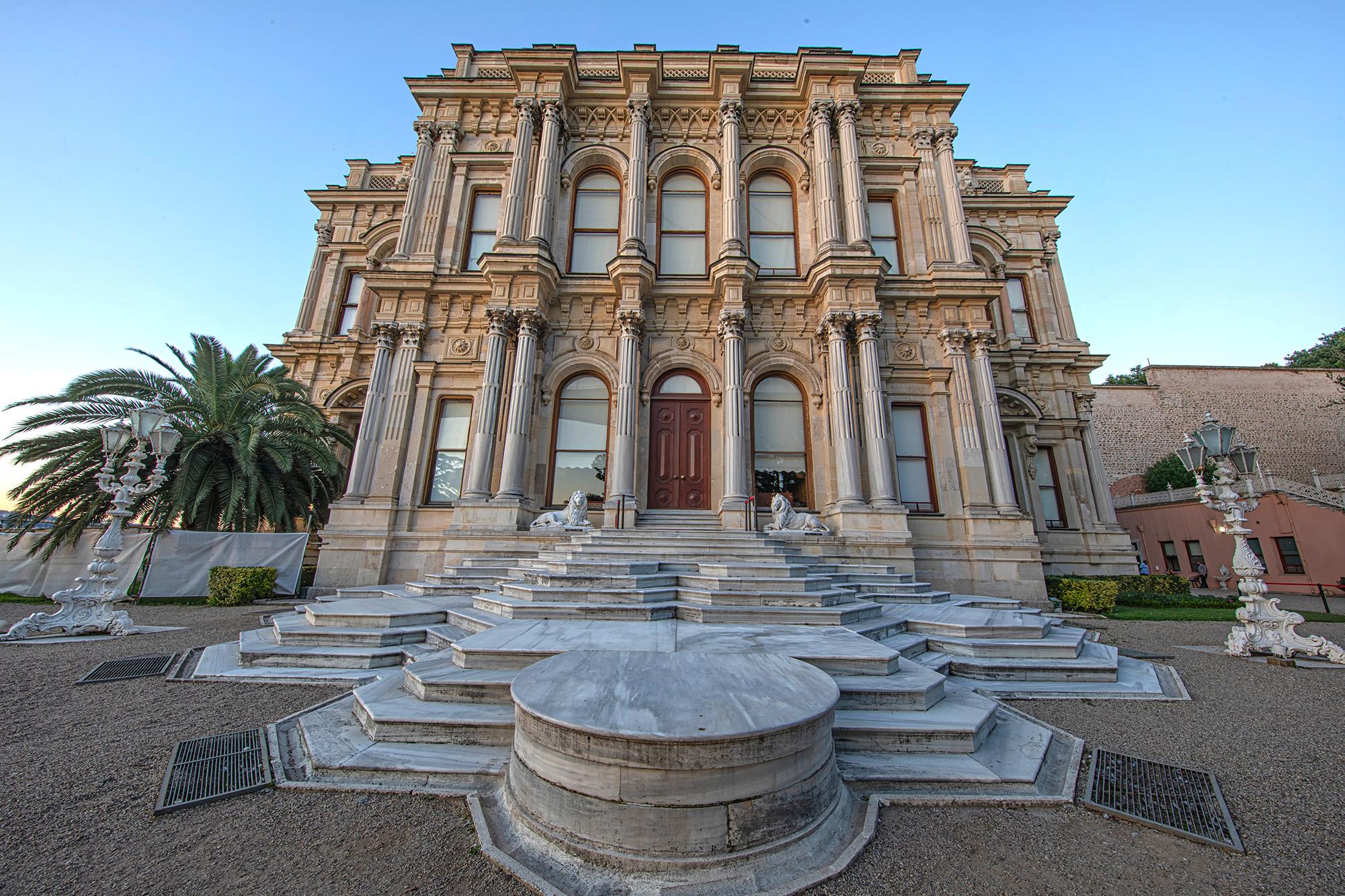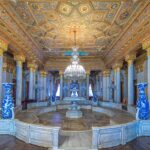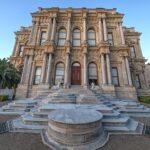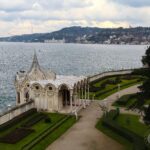Beylerbeyi Palace
Beylerbeyi Palace was conceived as a country residence for the Ottoman sultans and a state guesthouse to host foreign heads of state or monarchs, and was built upon the request of Sultan Abdülaziz (1861-1876), the sultan of the period. The construction of the palace started on 6 August 1863 and it was officially opened for use with a ceremony on Friday, 21 April 1865. The construction organisation of the palace was carried out by Ebniye-i Şâhâne Serkalfa (chief architect of the palace) Serkiz Bey (Balyan). Mehmed Efendi, Mahmud Efendi and Rıfat Efendi were in charge of the financial and administrative affairs of Beylerbeyi Palace. It is determined that the palace cost approximately 500 thousand Ottoman liras.
Beylerbeyi Palace, the main structure of the collection of buildings, is a two-storey masonry building on a high basement. Built on an area of approximately 2,500 square metres, the building sits on a rectangular ground area. The southern part of the palace is organised as the Mabeyn-i Hümâyûn and the northern part as the Valide Sultan Apartment. There are a total of 6 halls, 24 rooms, 1 bath and 1 bathroom on both floors. Beylerbeyi Palace, which was built by mixing Western and Eastern styles, has the plan feature of a Turkish house with its Harem and Mabeyn sections. The roof of the building is hidden by a railing that hides all the facade edges from the top. The plan of the palace has a plan composition based on the central sofa (hall) motif with iwan. The scheme in Beylerbeyi Palace consists of three sections. These sections are the Mabeyn-i Hümâyûn, the Bed Chamber (Hünkâr Chamber) and the Valide Sultan Chamber. The main Harem section for the ladies and ikbal, which immediately follows the Valide Sultan Apartment and was built parallel to the sea, was built separately from the main structure; this structure has not survived to the present day. The entrance façade of the Mabeyn-i Hümâyûn shows an arrangement in which the Neo-baroque emphasis is more prominent. Like the masses and facades of the palace, the interior arrangements were also shaped with an eclectic approach.
Due to the passion of Sultan Abdülaziz, who had Beylerbeyi Palace built, for the sea, some of the frames and cartouches on the ceilings of the palace are decorated with sea and ship themes; Sultan Abdülaziz even drew patterns with sea and ship themes to give ideas to painters.
BEYLERBEYI PALACE IN HISTORY
Beylerbeyi Palace was used as a summer palace by its founder Sultan Abdülaziz (1861-1876). During the reigns of Sultan Abdülaziz and Abdülhamid II, the palace gained the function of a state guesthouse when it started to be allocated to foreign rulers or presidents during their official visits. The first important guest hosted at Beylerbeyi Palace was Empress Eugénie of France. This visit of the Empress was organised in return for Sultan Abdülaziz’s 1867 visit to France. Other foreign guests hosted at Beylerbeyi Palace during the reign of Sultan Abdülaziz were Emperor Joseph of Austria-Hungary (1869), Crown Prince Frédéric Guillaume Nicola Charles of Prussia (1869), Crown Prince of Italy (1869), Shah Nasser al-Din of Iran (18 August 1873).
During the 33-year reign of Sultan Abdülhamid II (1876-1909), Beylerbeyi Palace also functioned as a museum visited especially by foreign state protocol. During this period, along with Beylerbeyi Palace, Dolmabahçe Palace and Topkapı Palace Treasury-i Hümâyûn were also used as reign museums that could be visited with the permission of the Sultan. Immediately after Sultan Abdülhamid II was deposed, he was subjected to compulsory residence in the Alatini Mansion in Thessaloniki, but he was transferred to Istanbul approximately 3 years later due to the outbreak of the Balkan War. The new compulsory residence chosen for Abdülhamid II was Beylerbeyi Palace. The former Sultan spent the last 6 years of his life in this palace and closed his eyes in this palace on 10 February 1918.
Additional Buildings and Gardens
The Marble Kiosk: Built as a hunting lodge by the order of Sultan Mahmud II between 1829-1832, the Marble Kiosk is named for its marble outer walls. It features a fountain and a pool inside.
The Yellow Kiosk: Located near the Marble Kiosk, the Yellow Kiosk faces the garden on one side and the street on the other. This two-story building with a basement is an outstanding example of the period, boasting beautiful ceilings and interior decoration.
Stable Kiosk: Situated at the top of the terraced garden, this kiosk represents Ottoman horse culture. The Entrance Hall’s ceiling features horses and other animal figures. The stable comprises 20 stalls on each side, and its chandeliers and fittings are adorned with horse head and eye motifs.
Palace Gardens: Beylerbeyi Palace is a prestigious 19th-century building with gardens connected by ramps and stairs, spanning a total area of seventy thousand square meters. Magnolia, chestnut, linden, and judas trees were planted during Sultan Abdülhamid II’s reign.
Marine Kiosks: These two kiosks, one for the Mabeyn and the other for the Harem, resemble pergolas and are called “tent kiosks” and “new design kiosks.” Both have octagonal roofs and ceilings decorated with various animal figures.
How to Get There
You can get to the palace by taking IETT buses or minibuses from Üsküdar to Beylerbeyi, or by using the sea route to Beylerbeyi Pier.
CONTACT INFORMATION
Phone: +90 (216) 321 93 20
Address: Beylerbeyi Mah. Abdullah Ağa Cad. No:12, Beylerbeyi/Üsküdar
VISITING INFORMATION
Closed: Monday
Opening and Closing Hours: 09:00-18:00
Ticket Office Hours: 09:00-17:00
TICKET PRICES
Domestic Visitors: 45 TL Foreign Visitors: 130 TL Discounted Ticket Price: 20 TL Garden Ticket Price: 10 TL
The Museum Card is valid at palaces, kiosks, pavilions, museums, and historical factories affiliated with the Presidency of National Palaces, with some exceptions: Topkapı Palace Harem and Hagia Irene sections, Dolmabahçe Selamlık section, Beykoz Glass and Crystal Museum, and Küçüksu Pavillion Picnic area.
Discounted Selamlık tickets are available for local Museum Card holders who want to visit Dolmabahçe Palace’s Selamlık section. Topkapı Palace Combined Tickets are valid for 1 day, while Dolmabahçe Palace Combined Tickets are valid for 1 month, allowing single visits to different locations within that month.
Entrance is free for domestic and foreign visitors aged 0-6. Discounted tickets are offered to students aged 7-25 with a valid student ID card. Topkapı Palace is free for Turkish and TRNC citizens under 18, with discounted tickets available for citizens aged 18-25 (inclusive). Foreign students pay twice the discounted ticket price and must present their International Student Identity Card (ISIC).
The National Palaces Glass and Crystal Museum is free for domestic and foreign visitors under 12. A 20% discount is applied for tour companies bringing 20 or more visitors to the affiliated locations. Thematic Tours are held with three or more full-fare tickets.
The sites are closed or open during official holidays and religious festivals in 2023 as follows:
- New Year’s Day: Closed
- National Sovereignty and Children’s Day: Open
- Labor and Solidarity Day: Open
- 1st Day of Ramadan Bairam: Closed
- 2nd and 3rd Days of Ramadan Bairam: Open
- The Commemoration of Atatürk, Youth and Sports Day: Open
- Democracy and National Unity Day: Open
- 1st Day of the Feast of Sacrifice: Closed
- 2nd, 3rd, and 4th Days of the Feast of Sacrifice: Open
- Victory Day: Open
- Republic Day: Open
Beylerbeyi Palace Reviews 4.7 Excellent | 11,575 reviews
What visitors are saying: “I love that the audio guide is free.” “I was speechless, you can really feel Sultan Abdülhamid’s vibes.” “More subdued than Dolmabahce, but worth it.”
Visitors to Beylerbeyi Palace are providing positive feedback regarding the palace’s beauty and historical significance. The provision of a free audio guide helps visitors learn more about the history of the palace and the era. Additionally, visitors mention that the palace allows them to feel the atmosphere and energy of Sultan Abdülhamid. Despite being more subdued than Dolmabahce Palace, Beylerbeyi Palace is considered a place worth visiting.







